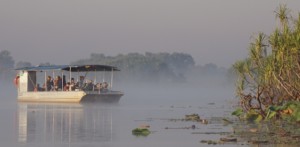AOC2019 was a great opportunity to discuss biogeography of Southern Hemisphere birds and to find out about the amazing research happening in Australia
Thanks to receiving a BOU member travel award, I was able to attend the 2019 Australasian Ornithological Conference (AOC2019) in Darwin, Australia. AOC is the peak scientific event for ornithological science in the Southern Hemisphere, jointly run by BirdLife Australia and Birds New Zealand. This year’s conference was the biggest ever, with more than 350 delegates presenting a diverse range of research. This was my first time attending AOC and I really enjoyed the meeting – the smaller size compared to larger US and European conferences made it easy to meet people, the quality of science was excellent, and the birding was unbeatable.
I presented my postdoc work on diversification of two endemic Malagasy families in the ‘Evolution of Australasian Birds’ symposium. This was a great opportunity to share my work with others working on Southern Hemisphere biogeography, and to road-test my results before submitting the paper for publication (it’s now in review). The symposium, led by Leo Joseph, had an exciting mix of talks focused on adaptation, hybrid zones, landscape genomics and biogeography. Other highlights in the scientific programme were the symposium on ‘Seabird Conservation’ hosted by the Australasian Seabird Group, and the session on ‘Climate and Birds’. Australian birds are facing new challenges as a result of climate change and I find the ongoing research in this area fascinating.
Thanks to the relatively small size of the meeting and the packed social calendar, networking seemed easier – and more fun! – than usual. The delegates were a diverse mix of academics, conservation practitioners, representatives from government and NGOs, all united by a love of Australasian birds. The collective voice of the conference is expressed in a statement “Extinction is not inevitable”, which you can read here. I came away from the meeting with many new ideas for my research, several potential collaborations for the future, and a desire to somehow incorporate more Australian birds in my research going forward.
 Birding Corroboree billabong at sunrise © Jane Younger
Birding Corroboree billabong at sunrise © Jane Younger
Of course, one of the most important parts of any ornithology conference is the birding, and it doesn’t get much better than Australia’s Top End! At the conference venue we were lucky to have a beautiful Tawny Frogmouth, Bush Stone-curlews, and a Frilled-neck Lizard hanging out in the garden all week. AOC offered a range of excursions to get out birding. I went on a sunrise cruise on local Corroboree billabong, where our group spotted more than 50 species of birds, including the iconic Black-necked Stork (jabiru to the locals).
The next AOC will be in 2021 in Auckland, New Zealand. It’s a great meeting and I’d highly recommend it if you work with Southern Hemisphere birds. See you there!
Nominate this article for a BOU Science Communication Award.




